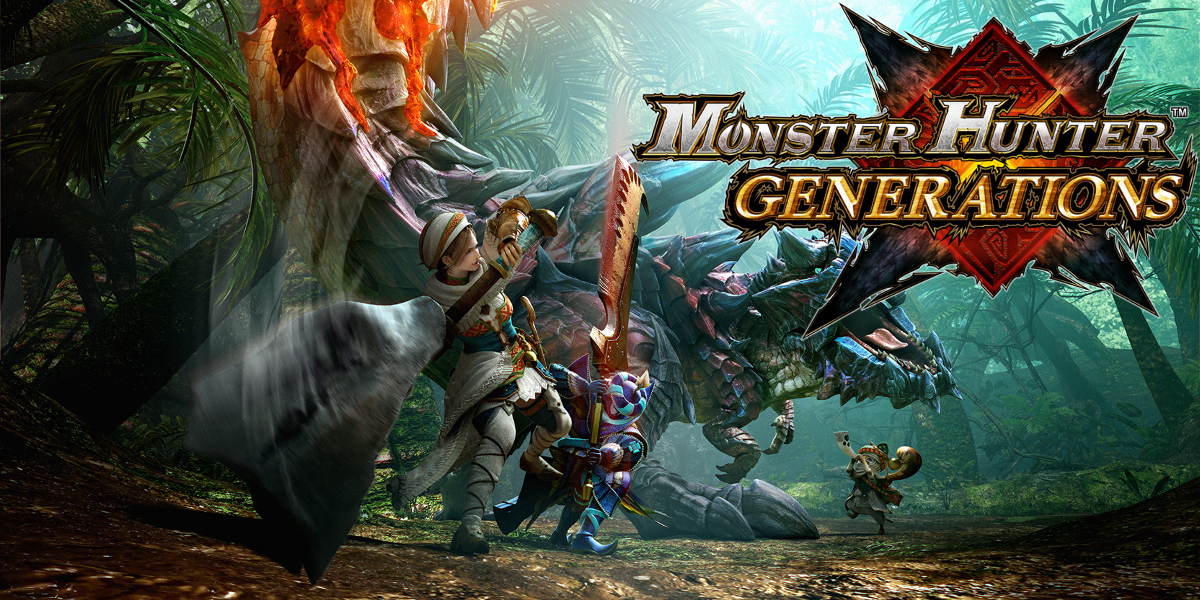It’s that time again for the hunting of beasts huge and small, from those of fantastical size to those smaller than a fly. Monster Hunter Generations is the next game in the series, following on from Monster Hunter 4 (which we reviewed here). Since there’s no storyline that runs through the game, there’s no need to worry about missing anything from before, so let’s go hunt something ugly!
If you’ve played Monster Hunter before, you’ll be right at home with Monster Hunter Generations, since it’s a lot of the same concept. You start your new hunter career in the town of Bherna (although you’re not really confined there following a few opening quests), gathering mushrooms and ferns for the good folks before earning enough money to buy gear good enough to last you through a fight against smaller monsters. This nets you more money, enough to buy newer stuff, or upgrade what you have provided you’ve gathered the right amount of materials beforehand. Everything escalates gradually in this way until you’re fending off beasts over a hundred times your size. It’s glorious.

Like MH4, you have access to Palicos, cat-like creatures that fight and hunt alongside you, and can handily stand in lieu of other human hunters. New to Monster Hunter Generations is the ability to actually become a Palico, and take on Palico-specific quests (called “Prowler” mode, vs the usual “Hunter” mode). In addition, the Palico Prowlers have access to costumes and gear that the human Hunter doesn’t, making it a very attractive alternative.

On the other hand, humans have something new that the Palicos don’t: Hunter arts. These arts are extra skills and abilities that take some time to charge up, but can quickly turn the tide of battle when used, especially when hunting the Bigger Things. The arts are divided into four different styles of use depending on how you like to play, but it would do you well to try them all and see which ones work for you if you’re unsure. I started off using one style, and then switched and found I preferred the second one more.
This early in the game’s release, the game’s Western online servers are still offline, so I was unable to play with others for review. The game also doesn’t support download-play, so everyone must bring their own copy. This meant, sadly, that this review will not cover multiplayer at all.

Replacing the guild is the Wycademy, which doesn’t quite hand out new quests in the same way, but still serves as a way of getting some juicier quests. The academy serves as a place to gather and find online hunters to participate in quests, although you’re free to use it to take on quests of a higher level than you can in-village. You earn Academy points in each hunt, and you can spend these points as well.
Gameplay-wise, it’s similar enough to prior Monster Hunter games that if you’re familiar enough with it, you can pretty much pick up and get going. Newer players will find this one even easier to get into than older games, and can actually be used as a springboard into the older Monster Hunter games, provided you’ve hunted everything there is to hunt in Monster Hunter Generations.

While I’d love to say that all of the game was visually striking, I can’t, because it appears that all the artists working at Capcom have no colourblindnesses, and neither do the QA teams. Some of the text was in a deep red colour that I found all but impossible to read against the brown/green background. Same deal for some quest boxes. The environments themselves, once you left the village, were good to look at and experience, and far less frustrating to navigate than MH4. Much of it fit together quite nicely and after a few runs around each area, I didn’t even need the map to navigate. And as usual, Capcom’s 3D guys are just brilliant. The 3D effects in Monster Hunter Generations are better than just about any other 3DS game.
If you hated Monster Hunter before, nothing I say is going to lure you back to the this one, but I have to admit it’s easier to get into and get addicted to than the previous games. It was never the kind of hack-n-slash action that more cinematic game are; it requires careful play, something I thought that many gamers today lack, but the current success of the Monster Hunter series, and the outstanding success of Monster Hunter Generations in Japan in particular, says I’m wrong. I like being wrong in these cases. Monster Hunter Generations is easily one of the best Monster Hunter games you’ll play.




1 reply on “We Review: Monster Hunter Generations”
The 3d effects in monster hunter generations are barely there. Go play mh4u and then play generations. There is no depth in this game and has some of the worst 3d effects. Mh4u had some of the best. They lowered convergence settings for 3d and there is barely any depth. I suggest you look at it again and fix it in your review because this is one of the main complaints people have with this game visually. They also lowered frame of from and the textures are worse in generations compared to 4u